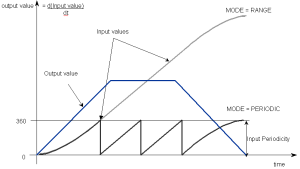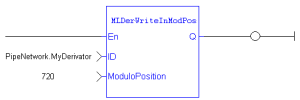MLDerWriteInModPos
![]()
 Function
Function![]() A function calculates a result according to the current value of its inputs. A function has no internal data and is not linked to declared instances. - Sets the Input ModuloPosition of the Derivator block.
A function calculates a result according to the current value of its inputs. A function has no internal data and is not linked to declared instances. - Sets the Input ModuloPosition of the Derivator block.
Inputs
|
Input |
Data Type |
Range |
Unit |
Default |
Description |
|---|---|---|---|---|---|
|
ID |
DINT |
-2147483648 to 2147483647 |
N/A |
No default |
ID number of an initiated Derivator object. |
|
ModuloPosition |
LREAL |
No range |
User units |
No default |
Designated new value of Input ModuloPosition of the selected Derivator object. |
Outputs
|
Output |
Data Type |
Range |
Unit |
Description |
|---|---|---|---|---|
|
Default (.Q) |
BOOL |
|
|
Returns TRUE if the Input ModuloPosition value is changed. See Pipe Network - General Rules for more information. |
Remarks
Input ModuloPosition is defined to manage the periodicity (modulo) of the input values.
Example
If the input value increases each millisecond by one degree then the output value is 1000 degrees per second.
Suddenly, the input value skips from 359 to 0 (zero).
- Input ModuloPosition = 360, the output continues to indicate 1000 degrees per second.
- This indicates that rollover into the next period has been properly handled
- Input ModuloPosition = 1000, the output then indicates 359,000 degrees per second.
- This indicates that the input has incorrectly interpreted roll-over as a 359 degree move in one millisecond.
Figure 6-182: MLDerWriteInModPos
-
-
The first calculation of a Derivator Pipe Block just after the pipe installation indicates 0 (zero) regardless of the initial input value.
FBD Language Example
FFLD Language Example
IL Language Example
Not available.
ST Language Example
//change the input MODULO_POSITION of a Derivator object to 720
MLDerWriteInModPos ( PipeNetwork.MyDerivator, 720 );
See Also









